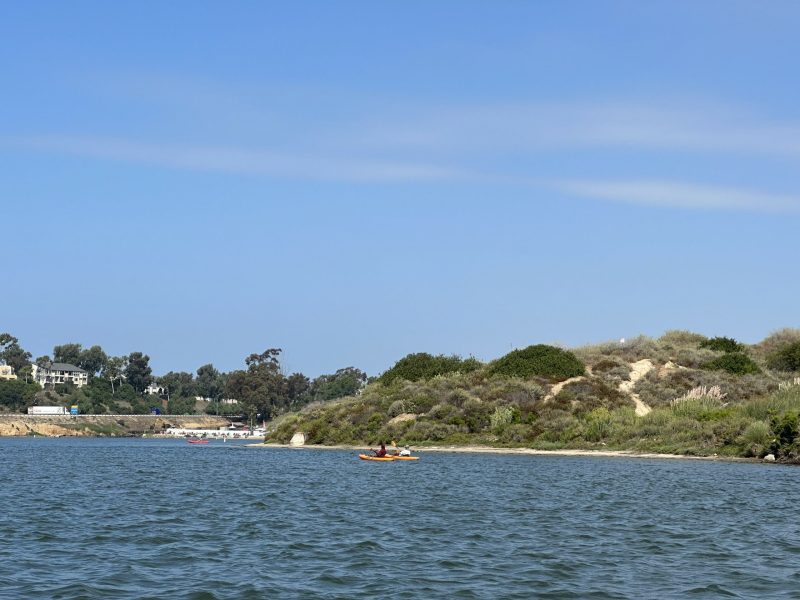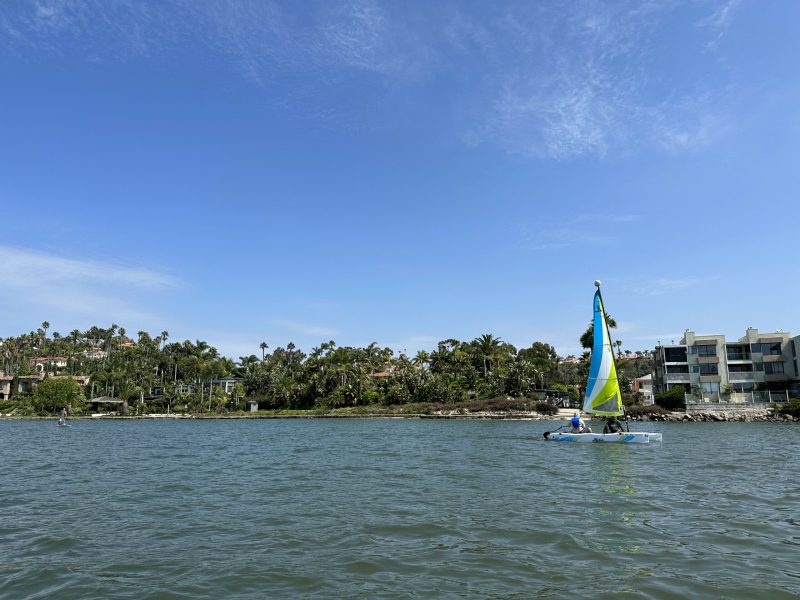Agua Hedionda Lagoon
The 400-acre Agua Hedionda Lagoon drains 135,000 acres in the metropolitan area of San Diego’s north county. The Lagoon watershed is home to juvenile fish, crabs, hundreds of species of marine life, and waterfowl, including an array of threatened and endangered species. It also provides a much-needed respite for migrating birds. The Lagoon is unique in that it has many current uses such as a YMCA day camp, recreational boating, a mussel and abalone aquaculture facility, a white-sea bass breeding and research center, and a power generating facility. The Lagoon’s various usages, and the many activities and ecosystems it supports, make it a distinctive natural resource.
Agua Hedionda is connected to the Pacific Ocean between Tamarack Avenue and Cannon Road and includes three inter-connected lagoons, which are divided by the I-5 freeway and the railroad bridge. Active uses such as boating, water skiing and wake boarding, personal watercraft use, sailing, windsurfing and fishing are allowed in certain areas.
The 66-acre outer lagoon, adjacent to the Pacific Ocean, allows shore fishing and provides intake water for the Carlsbad Desalination Plant. It’s also leased to an aquaculture company cultivating shellfish for a wide-ranging market. The 27-acre middle lagoon is home to the North Coast YMCA Aquatic Park. The 295-acre inner lagoon may be used for boating.
Stewardship of much of the lagoon is held by the Encina Power Station and its owner NRG Energy. In November 2000 the Agua Hedionda Lagoon was designated as a critical habitat for the tidewater goby.
The 186-acre Agua Hedionda Lagoon Ecological Reserve was acquired to protect southern willow riparian forest and saltwater marsh habitats. It was designated as an ecological reserve by the Fish and Game Commission in 2002. It consists of open water, salt marsh, and mudflat habitats at the eastern end of the lagoon. Many species of water-associated birds have been recorded in the area and the immediate environs. Mammals, amphibians, and reptiles also use this parcel and its riparian and chaparral habitats.


Wetland Expansion Potential
Wetland Migration
Upland area within the ecological reserve will allow landward migration of wetlands to keep pace with sea level rise up to ten feet.
Constraints to Expansion
The primary constraint is topography. The entire lagoon is surrounded by steep slopes. In a few places, the remaining area is further squeezed by existing development and infrastructure.
Land Acquisition
Most of the area with good potential is already included in the reserve. A few vacant parcels on the north shore outside the reserve do have some limited potential for natural wetland expansion. This could be expanded by recontouring the parcels to provide more low-elevation areas. Specific parcels that look like good candidates for acquisition include 2062000100, 2061720700, 2061720600, and 2061720500.
Some low-lying areas on the north shore are heavily developed. They will be significantly impacted by sea level rise above five feet. They may offer opportunities for managed retreat at some point.
Public Access
Recreation
The 66-acre outer lagoon, adjacent to the Pacific Ocean, allows shore fishing.
The 27-acre middle lagoon is home to the Magdalena Ecke Family YMCA’s Aquatic Park. The park was formerly only reserved for some summer campers. but it has since been opened to the public. “It’s just another way for us to serve our community,” says aquatics director Janelle De Santi. Offerings include on-the-water fun including kayaks, paddle boards, and inflatables as well as snack tables and fire rings on shore.
The 295-acre inner lagoon may be used for boating. To operate any vessel on the lagoon, you must meet certain requirements and purchase a permit. Permitted crafts include jet skis, power boats, and passive vessels, like sailboats and kayaks.
A commercial operation – California Water Sports – offers a variety of recreational opportunities at 4215 Harrison Street in Carlsbad. Services there include boat rentals, a convenience store, restrooms, showers, a snack bar, a swimming area, and transient berths or tie-ups. A small part of their property adjacent to the water will be impacted by sea level rise, but not enough to seriously disrupt their operations.
There is also a public launch area for non-motorized boats at the end of Bayshore Drive. There is public access via Bay Shore Drive, which is open for walking traffic from sunrise to sunset.
The Agua Hedionda Lagoon Discovery Center, located at 1580 Cannon Road, offers public programs and outreach activities, such as exhibits, lectures, and festivals celebrating the lagoon.
Trails
On the north side of the outer lagoon, trailheads at Carlsbad Blvd and Garfield Drive provide access to a short trail segment that also connects to the Coastal Rail Trail.
On the north side of the central lagoon, the Harbor Drive trailhead provides access to a short trail segment. An informal trail along the east side of the railroad provides access to the YMCA Camp.
On the north side of the inner lagoon, trailheads at Kelly Drive and Park Drive provide access to a short trail segment. At the end of Bayshore Drive, a walkway allows launching of non-motorized boats.
Transit
The Carlsbad Blvd trailhead is a short walk from a 101 bus stop at Carlsbad Blvd and Tamarack Ave, The 101 connects with Coaster Stations at Carlsbad Village and Poinsettia Ave.
The Nature Center is a short walk from a 444 bus stop at Faraday Ave and Whitman Way. The 444 connects with the Coaster at the Poinsettia Station.
The California Water Sports facility is about a half-mile walk from a 325 bus stop at Tamarack Ave and Pio Pico Drive The 325 connects to the Coaster at the Carlsbad Village Station and the Sprinter at the College Blvd station.

More information:
- Agua Hediondia Lagoon Foundation: Learn more about the lagoon’s ecosystem and opportunities to get involved.